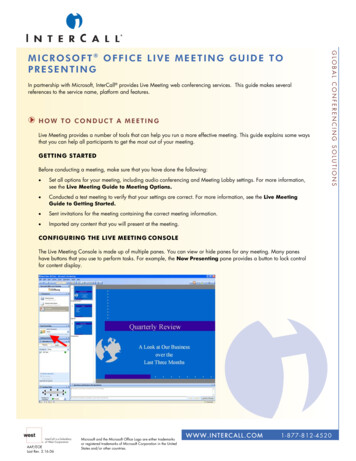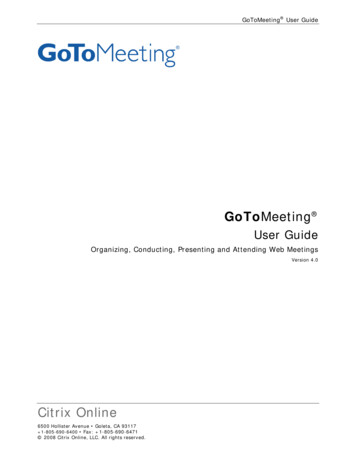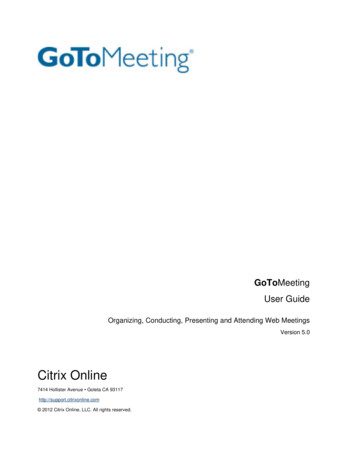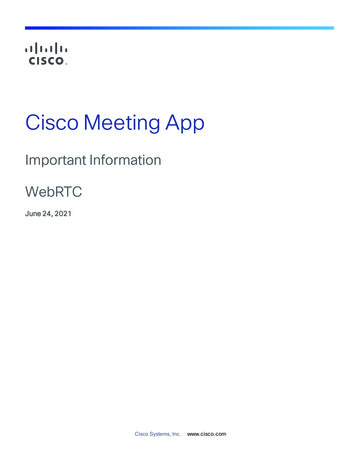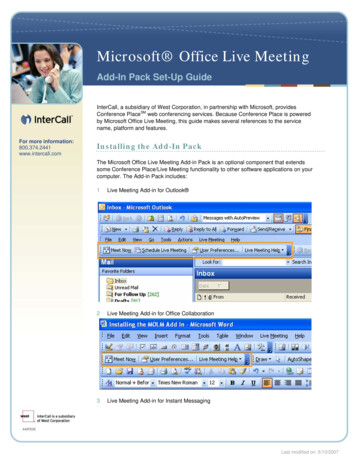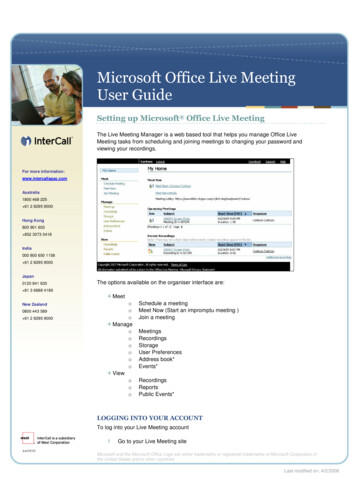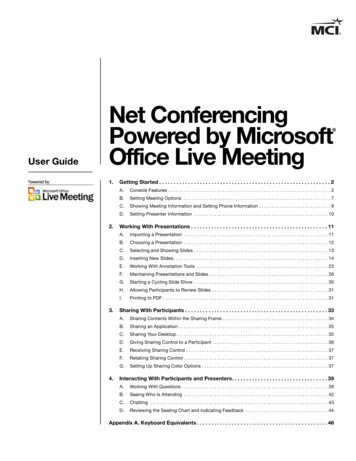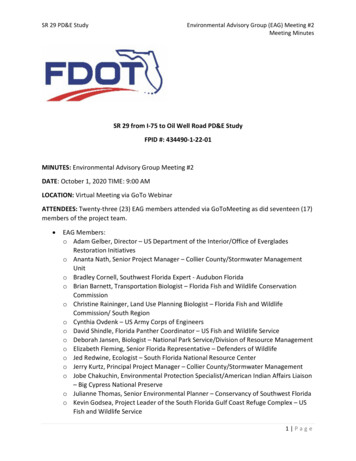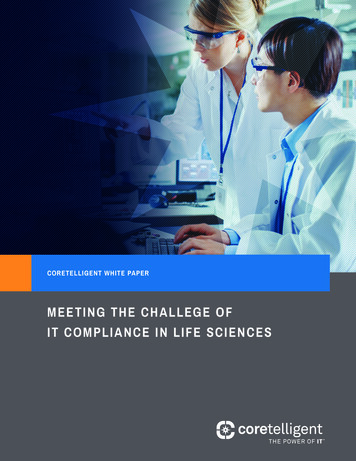
Transcription
CORETELLIGENT WHITE PAPERMEETI NG THE CH A LLEG E OFIT COMPLI A NCE I N LI FE SC I ENCES
A COMPLEX MANAGEMENT CHALLENGELife science organizations in the U.S. operate in one of the mostrigorously regulated industries in the world. From venture-fundedbiotechnology and genomics startups to commercial-stagepharmaceutical and diagnostics companies, all must comply witha host of regulations designed to protect patient safety, safeguardthe privacy of personal health information, and provide greatertransparency. Moreover, the compliance landscape is not static, withongoing rule changes that challenge organizations to continuallyevaluate and update their processes and controls to avoid falling outof compliance. This reality has placed ever-more responsibility on theshoulders of corporate compliance officers.At the same time, the role of information technology within the lifesciences industry has continued to expand. IT systems, applicationsand networks are inextricably woven into the fabric of life science organizations of all stripes—fromresearchers to pharmaceutical manufacturers to medical device makers. All rely on IT systems and data tofacilitate everything from clinical trials and R&D to product commercialization and customer support. Thiscompounds the complexity of the compliance challenge.TH E COST OF N ON CO M PLI A N C EThe financial impact of noncompliance can be crippling. With data breaches up by 480% in 2019 accordingto Information Age,1 this is a key area of potential vulnerability. In addition to causing tremendous damageto a company’s reputation and brand, a breach of protected health information (PHI) or other seriouscompliance failure could expose the organization to significant fines if regulators deem the company’ssafeguards were inadequate.Data breaches are not the only risk; there are many potential compliance pitfalls for life scienceorganizations. For example, in 2019 the state of Nevada’s Department of Health and Human Serviceslevied more than 17 million in fines on 21 diabetes drug manufacturers for non-compliance with the state’sprice transparency law.2 Passed in 2017, the law requires diabetes drug manufacturers to submit annualreports on its costs, profits, and other information related to product pricing.ORG A N I Z AT I ON A L C H A LLEN G ESDespite the significant risks posed by non-compliance, staffing in compliance and security departmentsis limited in many life science organizations—especially in early-stage companies. Compliance officersoften find themselves overworked, as they struggle to manage an increasingly complex matrix of rules andregulations, many of which involve the use of technology.Compliance officers often find themselves overworked, as they struggle to managean increasingly complex matrix of rules and regulations, many of which involve theuse of technology.1 ncial-services-firms-123479537/2 ansparency-law.htmlwww.cortelligent.com 2
The heightened role of technology in business operations also frequently causes a mismatch betweenthe skill set within the compliance department and the technical requirements that must be addressed.Compliance professionals may not be aware of potential vulnerabilities within the IT infrastructure thatcould expose sensitive data—including protected health information (PHI) and valuable intellectual property(IP)—to cyber theft. The rise of distributed computing models and cloud computing compounds thepotential risk, as critical data and applications are increasingly housed outside the enterprise data center.Even more concerning is the fact that in-house personnel may “not know what they don’t know,” making itdifficult for them to assess their compliance risk.THE INTERSECTION OFCOMPLIANCE AND ITLife science companies must by law comply with a host of federal and state regulations that involvetechnology and data protection. These include the following:FDA Title 21, CFR Part 11The U.S. Food and Drug Administration’s (FDA) Code ofFederal Regulations (CFR) Title 21, Part 11 is designedto ensure the reliability and accuracy of electronic recordsand electronic signatures. Part 11, as it is commonly called,requires that FDA-regulated entities implement effectivecontrols for systems that process data. This includes audits,audit trails, system validation and documentation, recordretention, and other controls to ensure the integrity ofelectronic records subject to FDA regulation.Data security is a key focus of Part 11. Compliance requires effective controls relating to system access,including defined roles and permissions, strong passwords and defined lockout mechanisms. This ensuresthat only authorized users can access the information—including both company employees and externalthird parties, such as Clinical Research Organizations (CROs) and suppliers of biospecimens for research.The proper use of eSignatures is also a focus, ensuring that identities of signing individuals can be verified withconfidence. This is normally accomplished using third-party software or software-as-a-service (SaaS) offerings.Traceability is another important aspect of Part 11. Companies must have clear audit trails to show whichuser performed what specific actions to records, and at what time, with version control information. Thismust be readily accessible to FDA auditors performing periodic inspections.Health Insurance Portability and Accountability Act (HIPAA)The federal Health Insurance Portability and Accountability Act of 1996 (HIPAA) sets forth requirementsfor protecting the confidentiality of protected health information (PHI). This includes information about anindividual’s health status, provision of healthcare, or payment for care. In fact, HIPAA defines no fewer than18 identifiers that must be handled with care—from names, social security numbers and email addressesto geographic locations and personal biometric identifiers. Ensuring systems and processes supportcompliance with strong data protection is a critical step for HIPAA compliance.One area of HIPAA that is often overlooked is the requirement that business associates (BAs) of regulatedentities comply with HIPAA requirements concerning protection of PHI. This applies to any third party whowww.cortelligent.com 3
accesses this data for the purposes of performing their work. Organizations should take care to craft BAagreements that clearly describe the permitted and required uses of PHI by the business associate anddefine appropriate safeguards.Health Information Technology for Economic and Clinical Health Act (HITECH)The expanding role of data—including personal, non-public health data—in the healthcare and lifesciences sector led to the enactment in 2009 of the Health Information Technology for Economic andClinical Health (HITECH) Act which regulates the use of digital media and systems for handling non-publichealth information.The HITECH Act gave additional strength to HIPAA enforcement, including significant penalties for willfulneglect of PHI safeguards. The Act gives individuals the right to obtain their PHI in electronic format andrequires that patients be notified of any unsecured data breach. For a breach impacting 500 or morepatients, the U.S. Department of Health and Human Services (HHS) must also be notified, triggeringpublic dissemination of the name of the non-compliant entity. This exposure can damage a life scienceorganization’s brand and reputation, and diminish its prospects in the eyes of potential investors.HIPAA and HITECH non-compliance can be extremely costly. In 2018, HIPAA fines were levied against11 organizations and topped 28.7 million—a 22 percent increase in total fines from the previous recordholding year, 2016.3 The risk of fines is not limited to large organizations and health systems. In 2018,the FDA fined Pagosa Springs Medical Center in Colorado 111,400 and mandated a corrective actionplan when a former employee continued to have remote access to confidential files after employmentseparation, without a BA agreement in place.4Sarbanes-Oxley Act (SOX)Publicly traded organizations must also comply with theSarbanes-Oxley Act of 2002 (SOX). Key technologyrelated requirements include the need to establish andenforce policies governing how accounting systems andother systems handling financial data are developed,modified and maintained. In addition, safeguards mustbe in place to prevent data tampering and protocols forresponding to data breaches must be developed andfollowed. Access to sensitive personal and financial datamust be monitored and recorded.Even though SOX compliance is not required for privately owned companies, it represents a set of best practicesfor managing risk. For venture-funded life science organizations, adopting SOX compliance early in theirprogression can help ease the transition if and when they go public or are acquired by a publicly traded company.Other relevant regulationsOrganizations that produce life science products should also comply with Good ManufacturingPractice (GMP) standards. Derived from FDA regulations, these standards help ensure that products areconsistently produced and controlled according to quality standards. Technology systems play a centralrole in assuring and documenting quality processes throughout the production lifecycle.3 html4 lwww.cortelligent.com 4
In addition to federal rules, life science organizations may need to comply with state regulations orguidelines. These often include specific reporting requirements that differ from one state to another. Whilecompliance officers will be familiar with rules regarding their financial controls in the states in which theyoperate, they may not be aware of what is required to ensure their IT platforms support compliance. Forfirms operating in multiple states, keeping track of these issues can be extremely complicated.With continually evolving regulations and cyber threats increasing in both frequencyand sophistication, maintaining compliance is a complex and time-consuming taskthat never ends.As noted previously, life science organizations may not have the in-house resources to effectively address thetechnical aspects of complying with these regulations and best practices. Moreover, compliance is not a “oneand done” proposition; with continually evolving regulations and cyber threats increasing in both frequencyand sophistication, maintaining compliance is a complex and time-consuming task that never ends.COLL A BOR AT I ON SOF T WA RE A N D CO M PLI A N C EAnother factor affecting compliance risk is the ubiquitous adoption of collaboration software, includingcloud-based collaboration platforms. These include productivity products like Google Docs, conferencingsolutions like Zoom and Skype, and file sharing tools like DropBox. By enabling knowledge workers toeasily exchange information and collaborate with colleagues and external partners anytime, anywherein the world, these tools offer attractive efficiencies. However, they can pose significant vulnerabilities forcompanies with regard to protecting sensitive data and complying with rules governing document retention.Critically, the firm may not even be aware that employees are using these popular platforms or, if they areauthorized, whether employees are using them compliantly.A recent industry survey found that many companies thatallow the use of collaboration platforms lack a written policyconcerning their use and that they have no solution in place forsupervising or archiving their use.5 Ensuring the organizationhas clear policies governing the use of such platforms,informed by a robust understanding of relevant regulationsand industry best practices, is crucial. These policies and theirenforcement mechanisms must be regularly reviewed andupdated as needed to ensure continued compliance.DU E D I LI G EN C E REQU ESTSFor companies actively pursuing investor support, merger and acquisition opportunities, or strategicpartnerships, a common challenge is a request for due diligence questionnaires (DDQs). Companies mustbe able to substantiate in detail the measures they have in place to safeguard data. Yet many compliancedepartments may not have the time and/or technical expertise to complete these DDQs satisfactorily, ortheir compliance and cybersecurity measures may not be up to the requisite standard. Both circumstancescould threaten a deal essential for the company’s research and/or commercialization.5 ration-software-risk/?utm source ao newsletter&utm campaign emailactivation&utm medium email&utm content 2019-12-17www.cortelligent.com 5
A COMPREHENSIVECOMPLIANCE STRATEGYBecause technology is so central to the operation of life science organizations, a comprehensive strategyfor IT compliance must encompass three key elements—the Three Pillars of IT Compliance:1 . D EFI N ED P O L I C I ES2 . EFFEC T I V E SYS TE M S3 . AT TES TAT I O NThe company should haveclear, written policies regardingaspects of technology thatimpact or contribute tocompliance. To ensure peoplethroughout the organizationtake them seriously, thesepolicies must have seniorleadership buy-in and activeenforcement.The company must havesystems in place to ensurecompliance is maintained.This includes robust perimetersecurity and monitoringsystems to guard againstunauthorized access toplatforms and data.The company must have upto-date reporting to satisfycompliance audit and examrequirements, and to keepcompliance officers and seniorleaders informed of the state oftheir compliance posture.A comprehensive strategy for IT compliance must encompass three key elements:defined policies, effective systems and attestation.Weakness in any one of these three areas could cause an organization to fall out of compliance—or, worseyet, expose their firm and its clients to risk, including the very serious consequences of cybercrime.K E Y SUCC ES S FACTORSTo satisfy the Three Pillars, organizations must ensure compliance across their entire technologyinfrastructure, including the following key factors:Vulnerability AssessmentA comprehensive assessment of systems and processes is needed to reveal compliance gaps and/orpotential vulnerabilities. This analysis provides valuable insight and actionable steps to address IT issuesthat could present compliance risk. Ongoing monitoring and assessment of potential risks is needed tokeep abreast of changes that impact IT platforms.Compliance Policy CreationThis step involves crafting compliance policies to mitigaterisks identified in the vulnerability assessment, tailored toyour business processes and IT environment. Authoringeffective policies requires a deep understanding of boththe IT infrastructure and the rules, regulations and bestpractices relevant to your organization—whether it is apublicly traded company or a venture-funded startup.These policies must be reviewed and revised to keeppace with changing compliance requirements andevolving technologies.www.cortelligent.com 6
Access ManagementEnsuring only authorized parties are able to access sensitive data is a critical step in compliance.Identifying potential intrusion risks early and closing the door on these vulnerabilities is a complex task,given the ever-changing cyber threats that target the life sciences sector.Intrusion Detection and ResponseContinuous threat intelligence ensures that you are always equipped to detect threats as they emerge. Themost proactive intrusion detection platforms are fully integrated with robust threat intelligence that providessecurity analysts with critical context. Ideally, threat intelligence will come from a variety of sources,including the open source community. In the event of a breach, having systems and procedures in place tolimit and mitigate the damage, and capture forensic data is essential.Cloud ManagementWhile public cloud services are growing in popularity due to their convenience, they may not provide thelevel of security demanded to ensure compliance with data protection and documentation regulations. Apurpose-built private cloud solution, developed to meet the specialized needs of financial organizations,can provide compliance assurance while offering all the advantages of cloud computing platforms.Backup & Disaster RecoveryA robust backup and disaster recovery solution is critical for preventing business interruption and lossof critical data, which could trigger a compliance violation. Off-the-shelf, onsite backup solutions do notprovide the level of performance required to meet the needs of financial organizations. Having the ability toperform frequent, granular backups of all systems and data, with secure data encryption at all points andrapid recovery, are essential success factors.Due Diligence Questionnaire (DDQ) SupportWhen responding to DDQs answering questions relating to cybersecurity and other IT-related issues be adifficult and time-consuming task for compliance professionals. Working with a partner who understandsboth compliance matters and technical details can be of immense help, providing investors with theinformation they need while freeing the compliance officer to focus their core business activities.As noted previously, many small and mid-market life science companies do not have the in-house expertiseto deal with all of these critical success factors. And, while many firms turn to an external managed serviceprovider (MSP) to help manage their IT environment and provide support, most MSPs do not have thein-depth knowledge of compliance requirements specific to life sciences needed to identify and mitigatepotential compliance gaps. This can leave the organization open to non-compliance, potentially resultingin fines, or to cyber attacks and data breaches. Any of these outcomes can lead to serious regulatory,financial or reputational consequences.WHAT TO LOOK FOR IN A MANAGEDSERVICE PROVIDER (MSP)To fulfill the Three Pillars of IT Compliance, it is important to work with an MSP that combines severalkey characteristics:Compliance Expertise. The MSP should be thoroughly familiar with regulations, rules and best practicesapplicable to the life sciences industry, including both federal and state regulations for all jurisdictions inwhich your firm operates. They should be able to point to a track record of success serving firms in yourparticular industry sub-segment.www.cortelligent.com 7
Breadth of Services. The MSP must be able to provide a comprehensive solution that encompassesall of the strategic pillars described earlier. This facilitates a holistic approach, eliminating gaps in ITmanagement that could cause compliance lapses (and the “finger pointing” that can result) while ensuringyou have a single, capable partner taking accountability for helping ensure the compliance of your entireIT infrastructure.Scale. Ramping up internal IT departments is costly and time-consuming. Small, “boutique” MSPs facethe same challenge and often cannot scale to meet expanding needs as your firm grows—especially ifthat growth involves expanding operations into other jurisdictions. Working with an MSP that has a criticalmass of professional resources and national reach provides the scalability needed to handle whateverthe future brings.Superlative Service. Your clients expect a high level of service and that’s what you should expect fromyour MSP. They should demonstrate the ability and willingness to provide rapid, effective service andsupport to your firm’s users—including special support for VIPs, such as home visits if required.THE CORETELLIGENT SOLUTIONCoretelligent offers the rare combination of attributes described above. We have a long track recordof serving life science organizations of all sizes and types address their IT needs. We understand thechallenges faced by pharmaceutical, biotech, genomics, therapeutics, and medical device companiesand CROs. And we provide customized solutions that enable them to maximize the return on their ITinvestments while helping ensure their compliance.Whether you have an in-house IT team that needs compliance-savvy reinforcement or a completeIT management solution, Coretelligent has the resources, knowledge and capabilities to help yourorganization manage risk and turn technology into a powerful tool for competitive advantage.To learn how Coretelligent can help you manage your IT compliance, visitwww.coretelligent.com or call 855.841.5888A BO UT C O R E TELL I G ENTCoretelligent is the IT support and private cloud service provider of choice for small andmid-sized businesses nationwide. Led by world-class technology experts, Coretelligentoffers best-in-class services covering a full range of technology needs: 360 Support,CoreCloud, CoreBDR, and CoreArmor. Top-tier organizations in the financial services,life sciences, technology, legal, and professional services sectors rely on Coretelligentto help maximize their technology return on investment. Founded in 2006, the companyhas offices in Massachusetts, Maine, New York, Connecticut, Pennsylvania, Georgia,and California.www.cortelligent.com 8
Sarbanes-Oxley Act (SOX) Publicly traded organizations must also comply with the Sarbanes-Oxley Act of 2002 (SOX). Key technology-related requirements include the need to establish and enforce policies governing how accounting systems and other systems handling financial data are developed, modified and maintained. In addition, safeguards must



